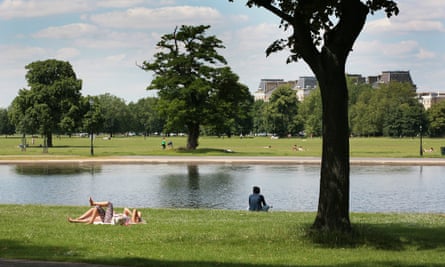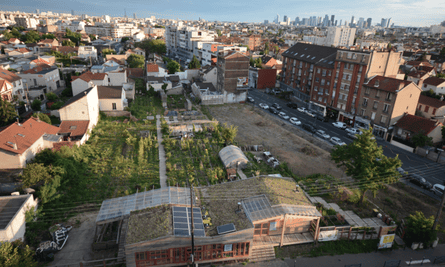It has become fashionable to talk about the “urban commons”, and it’s clear why. What we traditionally conceive of as “the public” is in retreat: public services are at the mercy of austerity policies, public housing is being sold off and public space is increasingly no such thing. In a relentlessly neoliberal climate, the commons seems to offer an alternative to the battle between public and private. The idea of land or services that are commonly owned and managed speaks to a 21st-century sensibility of, to use some jargon, participative citizenship and peer-to-peer production. In theory, at least, the commons is full of radical potential.
Why is it, then, that every time the urban commons is mentioned it is in reference to a community garden? How is it that the pioneers of a new urban politics are always planting kale and rhubarb? Can commoning be scaled up to influence the workings of a metropolis – able to tackle questions of housing, energy use, food distribution and clean air? In other words, can the city be reimagined as commons, or is commoning the realm of tiny acts of autarchy and resistance?
England has a particular history of commoning that is still written into the fabric of London. Wimbledon, Clapham, Ealing – they all have commons, where our forebears once had the right to graze their livestock. But the enclosures of the 18th century transferred the majority of common land into private hands, turning it into a marketable resource and creating a landless working class. And the problem of the commons today is that we still tend to think of it as a common resource, whether it be oceans and rivers or fish stocks.

This is a misunderstanding. Because we cannot have a common resource without a common strategy for managing it. Elinor Ostrom argued that the commons requires a set of rules. She won the Nobel prize in economics for proving that these resources need not succumb to the so-called “tragedy of the commons” (exploitation by someone taking more than their share) if a system of checks and balances prevails. And so, rather than a resource, the commons is a process, a set of social relations by which a group of people share responsibility for, yes, a garden or even the governance of their neighbourhood. As historian Peter Linebaugh has said, the commons is best understood as a verb.
The current popularity of the commons as an idea is partially driven by the internet and the fact that network tools make it so much more feasible for larger groups to self-organise. Open-source software, Wikipedia, the creative commons and social media make commoning possible while affirming the ethos of horizontal organisation. In urban terms, the fact that commoning most often takes the form of gardens in left-over plots or in the interstices is clearly because of the limited availability of land and because gardening presents a low barrier to entry compared to, say, construction. But even these garden initiatives are constantly under threat. In the late 1990s mayor Rudy Giuliani tried to sell off more than 100 community gardens in New York. And in Berlin, there was a struggle recently to protect the allotment gardens on the abandoned airfield of Tempelhof from developers.

In fact, it is often in moments of crisis that the idea of commons asserts itself. The protest movements that took over Tahrir Square in Cairo, Gezi Park in Istanbul and Zuccotti Park in New York transformed public space – state-owned, with the exception of Zuccotti – into a temporary commons through mass self-organisation. Similarly, the economic crisis in Greece has led to a resurgence of commoning in Athens, where parks neglected by the municipality started to be maintained by resident groups. And one could cite numerous examples of commoning in the favelas of Brazil, where many communities take pride in co-creating and self-managing their environment.
The question is whether the commons, with its potent political dimension, can transcend extreme need and symbolic resistance on the one hand and harmless local initiatives on the other. And there are encouraging examples. One commons project that is beginning to achieve an ambitious scale and complexity is in Colombes, in the suburbs of Paris. Since 2012, the Atelier d’Architecture Autogérée has been developing what its co-director, Doina Petrescou, calls “a bottom-up strategy of resilient regeneration” – and it goes beyond your average urban agriculture initiative. It’s true that there is a micro-farm for collective use but that is only one of three hubs, the others being a mini recycling plant and cooperative eco-housing.
The project now has 400 citizens co-managing 5000 square metres of land, producing food, energy and housing, while actively reducing waste and water usage. Already, by European standards, it is a fairly large-scale experiment in alternative urban living. But the aim is to add five more hubs over the next five years and to grow into a commons-based civic movement.

This is just one case study in how hundreds of ordinary citizens, not activists, can create an alternative urban economy. However, the question that always arises with the commons is, who is included? In contrast to public space, which is held by an authority for the benefit of all, commons can easily become enclaves. They tend to be determined by limited groups of stakeholders with a geographical attachment to a site. What happens when outsiders want to assert their right to that so-called commons?
Stavros Stavrides, a Greek academic specialising in spatial politics, is clear that for a commons to remain an open community it needs to be able to incorporate newcomers. “Commoning has to do with difference, not commonality, it should always be expanding those who can participate,” he said at a lecture on commons in London last month.
The bigger that community gets, the more complex the social relations. But that is not necessarily an impediment. The greater challenge, it seems, is whether commons can be sustained without an undue burden on the community. One of the most inspiring community initiatives in recent years has been the Campo de Cebada in Madrid, an abandoned lot that a group of architects and local citizens reactivated into a public square and cultural space. But members of the collective, Zuloark, confessed recently that they are tired. So the system of commoning needs to be sustainable otherwise its idealistic potential falls foul of a romantic underestimation of what it takes.

And recent political discourse has routinely, even cynically, made that mistake. The Tories’ aborted Big Society agenda invoked a vague volunteerism to paper over local authority budget cuts. With UK employees working the longest hours in Europe, when are we supposed to serve our communities? For commons-style thinking to take hold, we would need to move beyond quaint notions of the gift economy and engage in systemic restructuring.
Stavrides argues that for commoning to become more mainstream would require new kinds of institutions, specifically political ones. Thus far, political inspiration has come from outside Europe: from the water commons system in Cochabamba, Bolivia, or the Zapatistas in Chiapas, Mexico, or most recently the Syrian Kurds in Kobane. But that may be changing. With the election of Ada Colau of the Barcelona en Comú (Barcelona in Common) movement as mayor of Barcelona last month, commons-based governance finally has a foothold in a major European city. If movements like Barcelona en Comú can even begin to institutionalise a participative politics, then the commons may begin to reshape our understanding of citizenship and sustainability – and move the conversation beyond gardening.
- Theatrum Mundi’s Designing the Urban Commons exhibition is at the LSE Atrium Gallery from June 15 – July 11 as part of the London Festival of Architecture
- Community gardens and beyond: share your examples of ‘urban commoning’

Comments (…)
Sign in or create your Guardian account to join the discussion